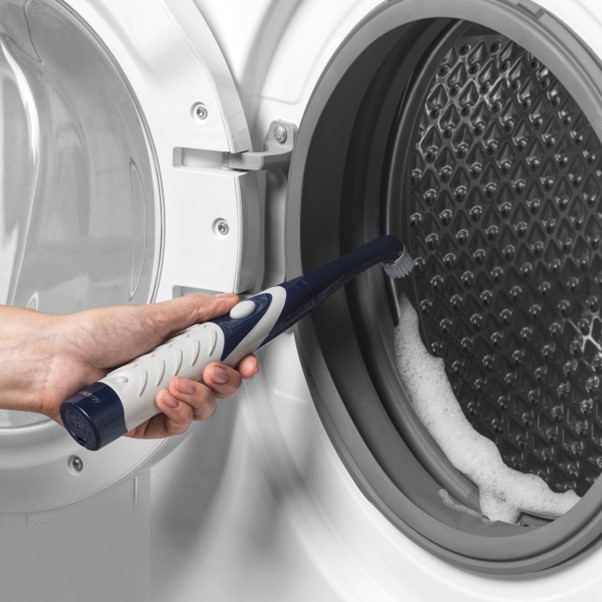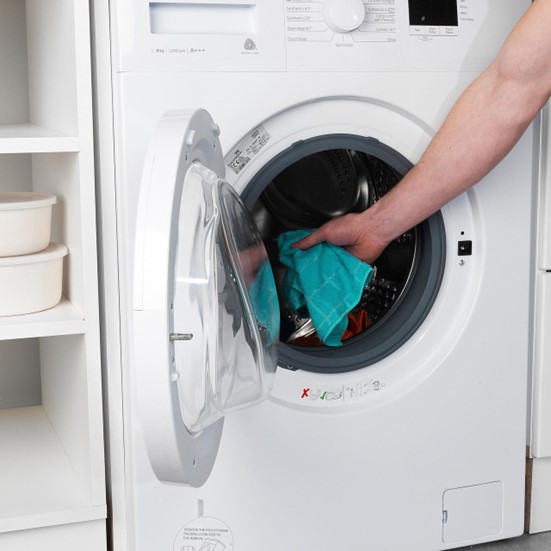Why does my washing machine smell?
Introduction

Why does my washing machine smell? Why isn’t it cleaning as well as it should? If you’ve ever wondered about these issues, you’re not alone. A smelly washing machine or inefficient washer is a common problem caused by detergent residue, dirt, and mould building up over time. This buildup not only impacts your washer’s performance but can also leave your laundry smelling less fresh.
Thankfully, the solution is simple! Follow this step-by-step guide to clean your washing machine and keep it running like new.
Before Starting
Before you begin cleaning your washing machine, it’s important to follow these general safety guidelines:
- Read the Instruction Manual: Always check the instruction booklet that came with your specific machine model. Manufacturers may recommend certain cleaning cycles or advise against using specific products.
- Wear Gloves: Protect your hands when handling cleaning solutions, as some may irritate the skin.
- Avoid Eye Contact with Cleaning Products: Be cautious when using vinegar, bleach, or any other cleaning agents. If splashes occur, rinse your eyes thoroughly and seek medical advice if needed.
Step-by-Step Guide to Cleaning a Washing Machine
No matter if you have a front-loading or top-loading washing machine, these steps will help keep it in top shape:
Clean the Drum
- Front-loading washing machines: Run an empty cycle with hot water and add 1 cup of white vinegar to the detergent drawer. Then, run a second cycle using 1 cup of baking soda to remove odours.
- Top-loading washing machines: Fill the drum with hot water and add 1 cup of white vinegar, leaving it to soak for 1 hour. Once complete, run a full cycle and repeat the process with baking soda.
Scrub the Seal (For Front Loading Washing Machines)
A washing machine seal, also known as a rubber gasket, fits between the drum and the door. These can be a great place for mould to hide but can be quite fiddly to clean. Use a detail brush with a mixture of water and white vinegar or an antibacterial cleaner to remove mould or mildew efficiently.
Clean the Detergent Drawer
Remove the drawer if possible and rinse under warm water. Use a Turbo Brush to scrub away any residue before drying and reinserting.
Check and Clean the Filter
Cleaning the filter is a crucial step to keep your washing machine running efficiently. Here's how to do it:
- Locate the Filter: Refer to your instruction manual to find the filter, typically located at the front bottom of the machine behind a small access panel.
- Prepare for Water Spillage: Many washing machines retain water in the sump, which can flood out when the filter is removed. Check if your machine has a small drainage hose to help you empty the water safely into a bucket or wash basin before opening the filter. If not, keep towels or a shallow tray handy to catch any spills.
- Remove and Rinse the Filter: Take out the filter and rinse it thoroughly under running water to clear lint, debris, or trapped items like coins or buttons. Use a soft brush to dislodge any stubborn buildup.
- Reinstall the Filter: Once clean, securely place the filter back into the machine to avoid leaks.
Wipe the Exterior

Finally, use a damp Microfibre Cloth to clean the outside of the washing machine by wiping down the door and visible panels.
How Often Should You Clean Your Washing Machine for The Best Results?
To maintain your washing machine's performance and prevent grime build-up, it is important to clean your washing machine regularly:
- Drum and detergent drawer: Once a month
- Seal and filter: Monthly
- Exterior wipe-down: Once a week
How to Keep Your Washing Machine Cleaner for Longer
So, you’ve successfully cleaned your washing machine, but how do you keep it clean for longer?
- Leave the washing machine door open after each use
- Check your filter regularly
- Clean the door seals once every month to avoid mould sinking into the rubber
- Avoid overloading the washing machine to prevent detergent accumulation
FAQ: Common Questions About Cleaning Washing Machines
Why does my washing machine smell bad?
A musty smell is often caused by mildew or mould. Cleaning the drum, seal, and filter will help eliminate these odours.
How do I get rid of black spots on the seal or inside of the drum?
Black spots on the seal or inside of the drum are likely mould or mildew and can be cleaned with a mixture of water and white vinegar or a mould-specific cleaner to scrub affected areas.
Why is my washing machine not cleaning my clothes?
Your washing machine may not be cleaning your clothes due to detergent build-up. Clean the drum and detergent drawer regularly to avoid this. Additionally, a clogged filter can reduce water circulation. Clean this regularly too to prevent blockages.
Can you use white vinegar to clean a washing machine?
Yes, you can use white vinegar to clean a washing machine. White vinegar removes residue and dissolves limescale. Always remember to follow up with a rinse cycle to remove any lingering vinegar scent inside your washing machine.
Can I clean my washing machine while doing laundry?
No, you shouldn’t clean your washing machine while doing your laundry to avoid residue transfer to your clothes.
Conclusion
Keeping your washing machine clean and smell-free is essential for a healthy home. With regular maintenance, your laundry will stay fresh, and your washing machine will last longer. Check out Beldray’s range of Cleaning Products to make the job even easier!
